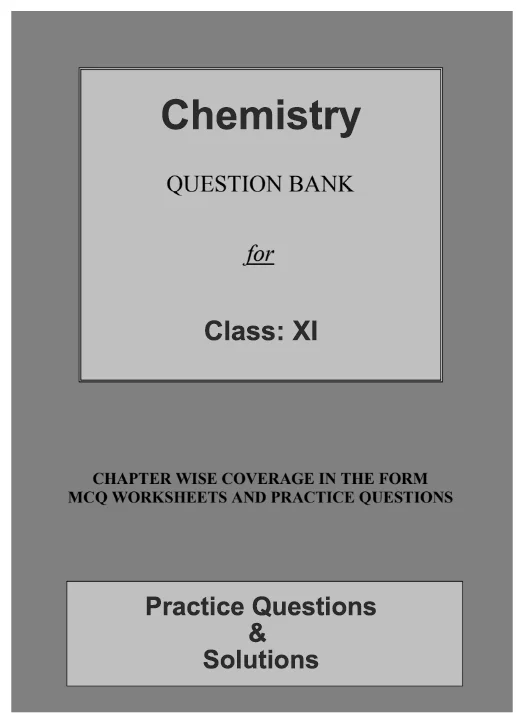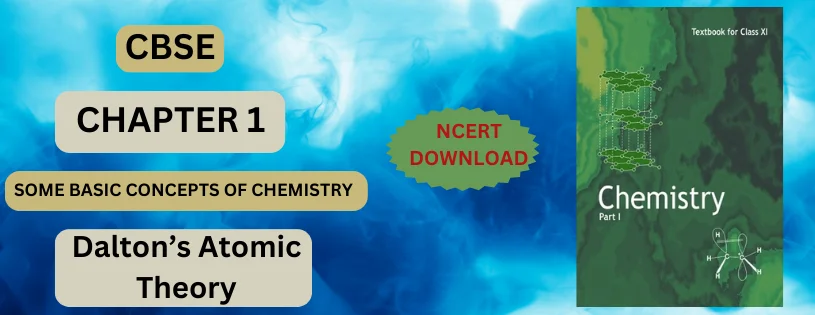Dalton's Atomic Theory, formulated around 1803, postulates several fundamental ideas. At its core, the theory proposes that matter is composed of indivisible particles called atoms, each possessing unique properties. These atoms combine in fixed ratios to form compounds, and during chemical reactions, they are rearranged, but not created or destroyed. Dalton's theory also introduced the concept that atoms of different elements have distinct masses, allowing for the establishment of atomic weights. This introduction to Dalton's Atomic Theory serves as a gateway to understanding the microscopic realm of matter, unraveling the mysteries that govern chemical interactions, and shaping the trajectory of modern chemistry.
Unraveling Dalton's Atomic Theory with CBSE NCERT Download
Dalton's Atomic Theory
Dalton's Atomic Theory, proposed by John Dalton in 1803, revolutionized chemistry. It posited that atoms are indivisible particles, conserving mass in chemical reactions. Dalton asserted that compounds form in fixed ratios, contributing to the development of stoichiometry. His theory emphasized the simplicity of atomic combinations and introduced chemical symbols. Although subsequent discoveries revealed its limitations, Dalton's work laid the foundation for modern atomic theory, shaping our understanding of matter and guiding further scientific inquiry into the microscopic world of atoms

What is Atomic Theory?
The fundamental building blocks of matter. Atomic theory has evolved over centuries as scientists have conducted experiments, made observations, and developed models to explain the properties of substances.
- Atoms as Building Blocks: Atoms are the basic units of matter and the smallest indivisible particles.
- Conservation of Atoms: In a chemical reaction, atoms are neither created nor destroyed.
- Different Types of Atoms: Atoms of different elements have distinct properties, such as mass and chemical behavior.
- Combination of Atoms: Atoms can combine to form molecules or compounds.
- Reorganization of Atoms: During a chemical reaction, atoms rearrange to form new substances, but the total number and types of atoms remain constant.
The development of atomic theory can be traced back to ancient philosophers, but it gained significant momentum in the 19th and 20th centuries with the contributions of scientists like John Dalton, J.J. Thomson, Ernest Rutherford, Niels Bohr, and others.

Download Chemistry Notes
Postulates of Dalton’s Atomic Theory
Dalton's Atomic Theory, proposed by John Dalton in the early 19th century, consists of several key postulates that form the basis of our understanding of atoms and molecules. Here are the main postulates of Dalton's Atomic Theory:
- Atoms as Indivisible Particles: Atoms are indivisible and indestructible; they cannot be divided into smaller particles.
- Conservation of Mass: In a chemical reaction, atoms are neither created nor destroyed. The total mass of the reactants is equal to the total mass of the products.
- Definite Proportions: Compounds are formed by the combination of atoms in simple, whole-number ratios. This implies that the ratio of masses of the elements in a compound is constant.
- Multiple Proportions: If two elements can combine to form more than one compound, the masses of one element that combine with a fixed mass of the other are in simple, whole-number ratios.
- Dalton's Law of Partial Pressures (not originally part of Dalton's theory): In a mixture of gases, the total pressure exerted by the mixture is the sum of the partial pressures of individual gases.
It's important to note that while Dalton's Atomic Theory was groundbreaking and laid the foundation for modern atomic theory, some of its postulates have been modified or refined in light of later scientific discoveries, particularly those related to subatomic particles and quantum mechanics.
Despite these limitations, Dalton's Atomic Theory laid the groundwork for the development of modern atomic theory. Despite these limitations, Dalton's Atomic Theory laid the groundwork for the development of modern atomic theory.
What are the Merits of Dalton’s Atomic Theory?
Dalton's Atomic Theory, proposed in the early 19th century, was a groundbreaking concept that significantly advanced our understanding of the nature of matter.
- Concept of Indivisible Atoms: Dalton's proposal of atoms as indivisible particles was a revolutionary idea at the time.
- Conservation of Mass: The idea that mass is conserved in chemical reactions was a crucial contribution.
- Definite Proportions: Dalton's postulate that compounds are formed in fixed ratios by the combination of atoms is generally accurate.
- Multiple Proportions: The idea that different compounds formed by the same elements have ratios of whole numbers contributed to the understanding of chemical combinations and reactions.
- Chemical Symbols: Dalton introduced the use of symbols to represent elements and compounds, contributing to the development of a standardized language in chemistry.
- Dalton's Law of Partial Pressures (later addition): While not originally part of Dalton's theory, his work on gas mixtures and the development of the law of partial pressures was an important contribution to the understanding of gas behavior.
- Quantitative Approach: Dalton's emphasis on quantitative measurements in chemistry laid the groundwork for a more rigorous and systematic approach to experimental science.
- Empirical Foundation: Dalton's Atomic Theory was based on empirical observations and experimental evidence.
Despite the subsequent modifications and advancements in atomic theory, Dalton's contributions were instrumental in shaping the field of chemistry and providing a framework for further scientific inquiry.
CBSE Class 11th Downloadable Resources:
Being in CBSE class 11th and considering the board examinations you must be needing resources to excel in your examinations. At TestprepKart we take great pride in providing CBSE class 11th all study resources in downloadable form for you to keep you going.
Below is the list of all CBSE class 11th Downloads available on TestprepKart for both Indian and NRI students preparing for CBSE class 11th in UAE, Oman, Qatar, Kuwait & Bahrain.
SAMPLE PRACTICE QUESTIONS OF SIGNIFICANT FIGURES:
Q1: Who proposed Dalton's Atomic Theory, and when was it proposed?
Answer. John Dalton proposed Dalton's Atomic Theory in the early 19th century. The theory was first presented in 1803.
Q2: What is the significance of Dalton's Law of Multiple Proportions?
Answer. Dalton's Law of Multiple Proportions states that when two elements form more than one compound, the ratios of the masses of one element that combine with a fixed mass of the other are in simple whole numbers. This law provided crucial evidence for the atomic theory.
Q3: Were there any limitations to Dalton's Atomic Theory?
Answer. Yes, one limitation was Dalton's assumption that atoms are indivisible, which we now know is not true. Additionally, the theory did not account for the existence of isotopes.
Q4: How did Dalton view the structure of atoms?
Answer. Dalton viewed atoms as indivisible particles, like tiny, indestructible spheres, and he did not propose any internal structure for atoms.
Q5: Is Dalton's Atomic Theory still relevant today?
Answer. While some aspects of Dalton's Atomic Theory have been modified or expanded upon with the development of modern atomic theory, the fundamental idea that matter is composed of indivisible particles (atoms) remains relevant.

Download Question Bank


Post a Comment